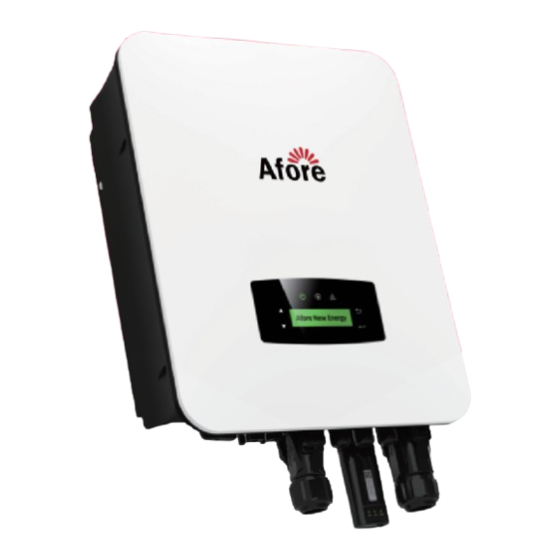
Summarization of Contents
About This Manual
Scope of Validity
Describes the manual's purpose and applicability to Afore Single Phase Hybrid Inverters.
Target Group
Defines the intended audience as qualified personnel for manual tasks.
Safety & Symbols
Safety Precautions
Lists essential safety guidelines for inverter installation and operation.
Explanations of Symbols
Explains various safety symbols and their meanings used in the manual.
Introduction
Basic Instruction
Introduces the hybrid inverter's function in increasing homeowner energy independence.
Self-Use Mode
Explains the Self-Use mode for optimizing self-consumption and grid export.
Time of Use Mode
Details the Time of Use mode for reducing electricity bills during peak periods.
Discharge Settings
Describes discharge settings within the Time of Use mode.
Forbidden Discharge
Explains the Forbidden Discharge setting for batteries.
Selling First Mode
Explains the Selling First mode suitable for high feed-in tariff regions.
Back-Up Mode
Describes the Back-Up mode for supplying loads during grid failures.
Installation
Unpacking & Package List
Details how to unpack the inverter and check all components for completeness and damage.
Product Overview
Provides dimensions and a general overview of the hybrid inverter's physical appearance.
Mounting Location
Specifies ideal locations and environmental conditions for inverter installation.
Inverter Terminals
Describes the function of each terminal connection on the inverter.
Mounting Instructions
Illustrates correct and incorrect orientations for mounting the inverter.
Installation Space Requirements
Specifies the necessary clearance around the inverter for access and maintenance.
Mounting
Details the step-by-step process for physically mounting the inverter unit.
Electrical Connection
Overview of connecting the inverter to PV, Battery, and AC power sources.
Communication Adapter Pin Assignment
Table showing pin assignments for communication adapter connections.
PV Connection
Guidelines and requirements for connecting PV panels to the inverter's MPPT channels.
Battery Connection
Instructions for connecting the battery to the hybrid inverter.
BAT-CAN/RS485 Connection
Wiring diagrams for establishing BAT-CAN/RS485 communication.
Multi Inverter Parallel
Instructions for configuring and connecting multiple inverters in parallel.
AC Connection
Guidelines for connecting the inverter to the AC grid and EPS.
CT or Meter Connection
Instructions for connecting current sensors (CT) or meters for monitoring.
Install the Meter
Explains the procedure for connecting the Afore Meter.
Communication Connection
Details on connecting communication modules like Wi-Fi, Ethernet, GPRS, RS485.
Install Communication Modules
Step-by-step guide for installing WIFI, Ethernet, GPRS, or RS485 modules.
Operation
Control Panel Overview
Describes the inverter's LCD display, LED indicators, and touch buttons.
Menu Overview
Provides a visual map of the inverter's LCD menu structure and options.
Inverter Setting
Introduces the process for configuring various inverter parameters.
Time & Date Settings
Instructions for setting the system time and date on the inverter.
Safety Settings
Explains the configuration of safety-related parameters.
Lithium Battery Settings
Details the settings specific to Lithium battery types.
PV Mode Settings
Configuration options for different PV operating modes.
Lead Acid Battery Settings
Details the settings specific to Lead Acid battery types.
Energy Management System (EMS Param)
Configuration of EMS parameters and selection of operating modes.
Time of Use Operation
Settings for timed charge and discharge operations based on time-of-use tariffs.
AC Charging Settings
Configuration options for AC charging the battery.
Forced Charging Settings
Instructions for setting up forced charging of the battery.
Forced Discharging Settings
Instructions for setting up forced discharging of the battery.
Protection Parameters
Configuration of various protection parameters for safe operation.
Power Grid Control Settings
Settings for controlling power output to the grid.
Multi-machine Parallel Settings
Configuration for parallel operation of multiple inverters.
Diesel Generator Setting
Configuration parameters for integrating a diesel generator.
Power ON/OFF
Diesel Generator Settings
Parameters for diesel generator enable and time control.
Pre-testing Requirements
Checks to perform before testing the inverter's power functions.
Maintenance & Trouble Shooting
Power ON Procedure
Steps for correctly powering on the hybrid inverter.
Power OFF Procedure
Steps for correctly powering off the hybrid inverter.
Restart Procedure
Procedure for safely restarting the hybrid inverter.
Periodic Maintenance
Recommended maintenance tasks for PV, AC, Battery, and Earth connections.
Trouble Shooting Guide
Guidance on identifying and resolving fault messages displayed by the inverter.
Fault Code and Trouble Shooting
Table listing fault codes, names, descriptions, and recommended solutions.
PV Faults
Lists PV-related fault codes and their corresponding troubleshooting solutions.
Battery Faults
Lists battery-related fault codes and their corresponding troubleshooting solutions.
Grid Faults
Lists grid-related fault codes and their corresponding troubleshooting solutions.
Off-grid Faults
Lists off-grid related fault codes and their corresponding troubleshooting solutions.
DC Faults
Lists DC-related fault codes and their corresponding troubleshooting solutions.
AC Faults
Lists AC-related fault codes and their corresponding troubleshooting solutions.
System Faults
Lists system-related fault codes and their corresponding troubleshooting solutions.
Inner Warning
Lists internal warning messages and their recommended solutions.
Outside Warning
Lists external warning messages and their recommended solutions.











Need help?
Do you have a question about the AF6K-SLP and is the answer not in the manual?
Questions and answers